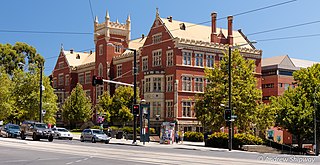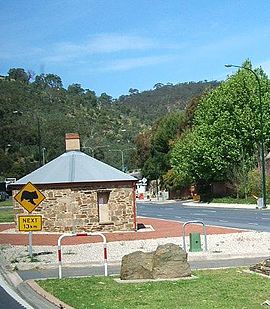
Adelaide is the capital and most populous city of South Australia, and the fifth-most populous city in Australia. "Adelaide" may refer to either Greater Adelaide or the Adelaide city centre. The demonym Adelaidean is used to denote the city and the residents of Adelaide. The traditional owners of the Adelaide region are the Kaurna. The area of the city centre and surrounding Park Lands is called Tarndanya in the Kaurna language.

South Australia is a state in the southern central part of Australia. It covers some of the most arid parts of the country. With a total land area of 984,321 square kilometres (380,048 sq mi), it is the fourth-largest of Australia's states and territories by area, and second smallest state by population. It has a total of 1.8 million people. Its population is the second most highly centralised in Australia, after Western Australia, with more than 77 percent of South Australians living in the capital Adelaide, or its environs. Other population centres in the state are relatively small; Mount Gambier, the second-largest centre, has a population of 26,878.

The University of Adelaide is a public research university based in Adelaide, South Australia. Established in 1874, it is the third-oldest university in Australia. Its main campus in the Adelaide city centre includes many sandstone buildings of historical and architectural significance, such as Bonython Hall. It is co-located on its east with the historical Royal South Australian Society of Arts. The institution, which predates the university, then included the Art Gallery of South Australia, the South Australian Museum and the State Library of South Australia where studies were conducted prior to its construction. It is also adjacent with the Australian Space Agency headquarters on Lot Fourteen, through which it plays a notable role in the Australian space industry.

Urrbrae Agricultural High School is a public high school in the Australian state of South Australia, with 1,500 students. The school is located in the Adelaide suburb of Netherby, about 5 kilometres (3.1 mi) south-east of the Adelaide city centre. It is adjacent to the Waite Agricultural Research Institute of the University of Adelaide, the CSIRO Agricultural Research facilities in the suburb of Urrbrae, and various other agricultural and horticultural facilities established by Peter Waite, the University of Adelaide, and the South Australian state government.

Belair is a suburb in the south eastern foothills of Adelaide, South Australia at the base of the Mount Lofty Ranges.
Torrens Park is a mainly residential large inner-southern suburb of Adelaide, incorporating some of the foothills and adjacent to the original "Mitcham Village". It was named after Sir Robert Richard Torrens, the instigator of the Torrens title system of land registration and transfer, who built a large home in the area which he named Torrens Park.

The City of Mitcham is a local government area in the foothills of southern Adelaide, South Australia. Within its bounds is Flinders University, South Australia's third largest, and the notable, affluent suburb of Springfield which contains some of the city's most expensive properties.

Peter Waite was a South Australian pastoralist, businessman, company director and public benefactor. Waite's philanthropic endeavors provided significant benefit to the University of Adelaide and to local public schools, and generations of students have benefited from his largesse.

Waite is a single-member electoral district for the South Australian House of Assembly. Named after Peter Waite, a 19th century entrepreneur and philanthropist, it covers 75.4 km² of suburbs and foothills in Adelaide's inner south-east, taking in the suburbs of Belair, Blackwood, Brown Hill Creek, Coromandel East, Coromandel Valley, Crafers West, Craigburn Farm, Eden Hills, Glenalta, Hawthorndene, Kingswood, Lynton, Mitcham, Netherby, Springfield, Torrens Park, Urrbrae as well as part of Upper Sturt.
The Australian Wine Research Institute (AWRI) is a research institute with a focus on Australian wine, based in Adelaide, South Australia.
Netherby is an inner-southern suburb of Adelaide, South Australia which lies within the City of Mitcham. It is bordered by the suburbs of Springfield, Kingswood, Mitcham and Malvern.

Springfield is a green and hilly inner-southern suburb of the South Australian capital city of Adelaide. It is located in the foothills of the Mount Lofty Ranges, around 8 kilometres (5.0 mi) south-east of the Adelaide city centre. The suburb is part of the hills-face zone, with sweeping views over the Adelaide plains. Springfield is an affluent area containing many of South Australia's most valuable residential properties.
The South Australian Research and Development Institute (SARDI) is the principal research institute of the Government of South Australia, with a network of research centres, laboratories and field sites both in metropolitan Adelaide and throughout South Australia. SARDI is part of Primary Industries and Regions SA.
Rev. William Henry Mudie was an Anglican priest and educator in Adelaide, South Australia.

The Urrbrae Wetland is a constructed urban wetland in the Australian state of South Australia located in the suburb of Urrbrae in the Adelaide metropolitan area. It was constructed to manage flood water from the nearby Adelaide Hills and has been developed to provide ecological and educational benefits. The wetland covers approximately 6 hectares of land which is onsite of Urrbrae Agricultural High School. The area of water is approximately 4 hectares and when full, contains approximately 13.5 million litres of water.

Education in South Australia is primarily the responsibility of the South Australian Government.
Robert Forsyth Macgeorge was an early settler of South Australia who is remembered for founding the property which is now the Adelaide suburb of Urrbrae. A number of his children were prominent in the early history of South Australia and other Australian colonies.
Primary Industries and Regions SA (PIRSA), also known as Primary Industries and Regions South Australia, and the Department of Primary Industries and Regions SA, is an agency of the South Australian Government whose focus is the economic development of the state of South Australia. Its key areas of work include primary sector industries, and biosecurity.













